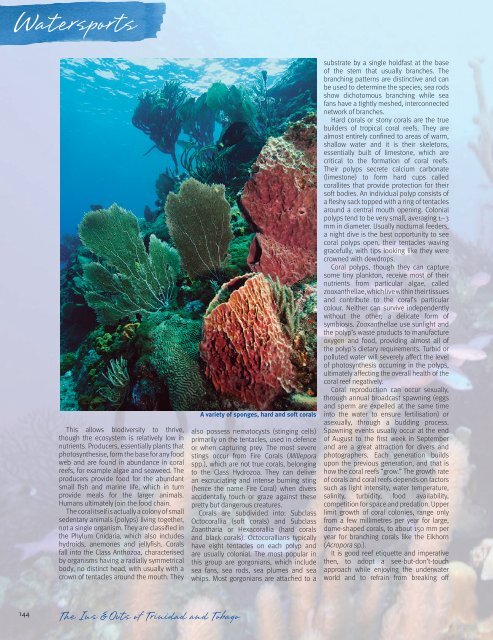f Paria - Ins and Outs of Trinidad & Tobago 2013
f Paria - Ins and Outs of Trinidad & Tobago 2013
f Paria - Ins and Outs of Trinidad & Tobago 2013
Create successful ePaper yourself
Turn your PDF publications into a flip-book with our unique Google optimized e-Paper software.
Watersports<br />
This allows biodiversity to thrive,<br />
though the ecosystem is relatively low in<br />
nutrients. Producers, essentially plants that<br />
photosynthesise, form the base for any food<br />
web <strong>and</strong> are found in abundance in coral<br />
reefs, for example algae <strong>and</strong> seaweed. The<br />
producers provide food for the abundant<br />
small fish <strong>and</strong> marine life, which in turn<br />
provide meals for the larger animals.<br />
Humans ultimately join the food chain.<br />
The coral itself is actually a colony <strong>of</strong> small<br />
sedentary animals (polyps) living together,<br />
not a single organism. They are classified in<br />
the Phylum Cnidaria, which also includes<br />
hydroids, anemones <strong>and</strong> jellyfish. Corals<br />
fall into the Class Anthozoa, characterised<br />
by organisms having a radially symmetrical<br />
body, no distinct head, with usually with a<br />
crown <strong>of</strong> tentacles around the mouth. They<br />
A variety <strong>of</strong> sponges, hard <strong>and</strong> s<strong>of</strong>t corals<br />
also possess nematocysts (stinging cells)<br />
primarily on the tentacles, used in defence<br />
or when capturing prey. The most severe<br />
stings occur from Fire Corals (Millepora<br />
spp.), which are not true corals, belonging<br />
to the Class Hydrozoa. They can deliver<br />
an excruciating <strong>and</strong> intense burning sting<br />
(hence the name Fire Coral) when divers<br />
accidentally touch or graze against these<br />
pretty but dangerous creatures.<br />
Corals are subdivided into: Subclass<br />
Octocorallia (s<strong>of</strong>t corals) <strong>and</strong> Subclass<br />
Zoantharia or Hexacorallia (hard corals<br />
<strong>and</strong> black corals). Octocorallians typically<br />
have eight tentacles on each polyp <strong>and</strong><br />
are usually colonial. The most popular in<br />
this group are gorgonians, which include<br />
sea fans, sea rods, sea plumes <strong>and</strong> sea<br />
whips. Most gorgonians are attached to a<br />
substrate by a single holdfast at the base<br />
<strong>of</strong> the stem that usually branches. The<br />
branching patterns are distinctive <strong>and</strong> can<br />
be used to determine the species; sea rods<br />
show dichotomous branching while sea<br />
fans have a tightly meshed, interconnected<br />
network <strong>of</strong> branches.<br />
Hard corals or stony corals are the true<br />
builders <strong>of</strong> tropical coral reefs. They are<br />
almost entirely confined to areas <strong>of</strong> warm,<br />
shallow water <strong>and</strong> it is their skeletons,<br />
essentially built <strong>of</strong> limestone, which are<br />
critical to the formation <strong>of</strong> coral reefs.<br />
Their polyps secrete calcium carbonate<br />
(limestone) to form hard cups called<br />
corallites that provide protection for their<br />
s<strong>of</strong>t bodies. An individual polyp consists <strong>of</strong><br />
a fleshy sack topped with a ring <strong>of</strong> tentacles<br />
around a central mouth opening. Colonial<br />
polyps tend to be very small, averaging 1–3<br />
mm in diameter. Usually nocturnal feeders,<br />
a night dive is the best opportunity to see<br />
coral polyps open, their tentacles waving<br />
gracefully, with tips looking like they were<br />
crowned with dewdrops.<br />
Coral polyps, though they can capture<br />
some tiny plankton, receive most <strong>of</strong> their<br />
nutrients from particular algae, called<br />
zooxanthellae, which live within their tissues<br />
<strong>and</strong> contribute to the coral’s particular<br />
colour. Neither can survive independently<br />
without the other; a delicate form <strong>of</strong><br />
symbiosis. Zooxanthellae use sunlight <strong>and</strong><br />
the polyp’s waste products to manufacture<br />
oxygen <strong>and</strong> food, providing almost all <strong>of</strong><br />
the polyp’s dietary requirements. Turbid or<br />
polluted water will severely affect the level<br />
<strong>of</strong> photosynthesis occurring in the polyps,<br />
ultimately affecting the overall health <strong>of</strong> the<br />
coral reef negatively.<br />
Coral reproduction can occur sexually,<br />
through annual broadcast spawning (eggs<br />
<strong>and</strong> sperm are expelled at the same time<br />
into the water to ensure fertilisation) or<br />
asexually, through a budding process.<br />
Spawning events usually occur at the end<br />
<strong>of</strong> August to the first week in September<br />
<strong>and</strong> are a great attraction for divers <strong>and</strong><br />
photographers. Each generation builds<br />
upon the previous generation, <strong>and</strong> that is<br />
how the coral reefs “grow.” The growth rate<br />
<strong>of</strong> corals <strong>and</strong> coral reefs depends on factors<br />
such as light intensity, water temperature,<br />
salinity, turbidity, food availability,<br />
competition for space <strong>and</strong> predation. Upper<br />
limit growth <strong>of</strong> coral colonies, range only<br />
from a few millimetres per year for large,<br />
dome-shaped corals, to about 150 mm per<br />
year for branching corals like the Elkhorn<br />
(Acropora sp.).<br />
It is good reef etiquette <strong>and</strong> imperative<br />
then, to adopt a see-but-don’t-touch<br />
approach while enjoying the underwater<br />
world <strong>and</strong> to refrain from breaking <strong>of</strong>f<br />
144<br />
The <strong>Ins</strong> & <strong>Outs</strong> <strong>of</strong> <strong>Trinidad</strong> <strong>and</strong> <strong>Tobago</strong>


